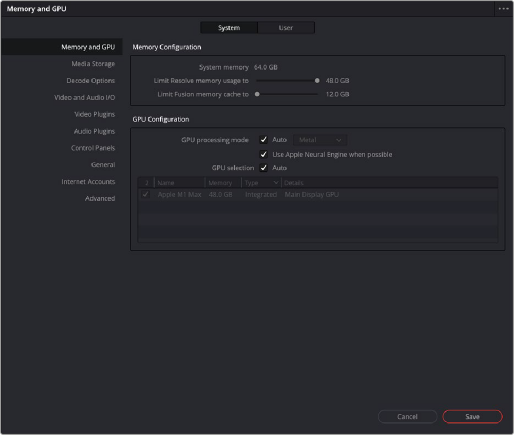< Previous | Contents | Next >
Individual Preferences and Settings Based on Login
![]()
As of DaVinci Resolve 16, there are individual preferences and settings for each login account on a given computer. This means that multiple artists can each have their own login, and DaVinci Resolve will maintain separate workspace layouts and preference states for each artist, depending on who’s logged in.
Preferences
The Preferences window, divided into System preferences and User preferences panels, lets you set up the overall environment of your DaVinci workstation, choosing what hardware to use with DaVinci Resolve and what user interface settings you prefer as you work.

The DaVinci Resolve preferences let you set up your environment
A quick overview of the most important System and User preferences appears below, with guidance about the first settings you should adjust when you first set DaVinci Resolve up on your workstation. However, for a comprehensive overview and for more information, see Chapter 4, “System and User Preferences.”
System Preferences
The System preferences let you configure the hardware DaVinci Resolve works with. If you have a system that doesn’t change very often, then you may only rarely use the Preferences window. On the other hand, if you’re working with a mobile system with changing video interfaces, control panels, and scratch volumes, then you may use this window more frequently.

NOTE: Whenever you change certain core System Settings in the Preferences, you may have to quit and restart DaVinci Resolve for those changes to take effect.
NOTE: Whenever you change certain core System Settings in the Preferences, you may have to quit and restart DaVinci Resolve for those changes to take effect.
NOTE: Whenever you change certain core System Settings in the Preferences, you may have to quit and restart DaVinci Resolve for those changes to take effect.
![]()
Lets you choose various options governing how to use the GPUs attached to your computer, and how to configure Viewers in different pages. This panel also provides an overview, for reference, of all hardware and computer characteristics that are relevant to DaVinci Resolve running smoothly, including a listing of installed GPUs.
This is a list within which you define the scratch disk used by your system. The first volume in this list is where Gallery stills and cache files are stored, so you want to make sure that you choose the fastest storage volume that’s connected.
These settings let you select various hardware options for decoding RAW files and H.264/H.265. It also lets you choose to use the easy DCP decoder and the ability to refresh growing any files (files that are in the process of being written) in the Media Pool.
The preferences in this panel let you choose which video and audio Capture and Monitor interfaces you want DaVinci Resolve to use on your workstation. If you have multiple Blackmagic Design
I/O interfaces connected to your computer, you can choose between them.
If you have any third-party Open FX plugins installed, you can see them and enable/disable them here.
If you have any third-party VST plugins installed, you can see them and enable/disable them here.
Lets you choose and configure (if necessary) a control panel that’s connected for use during grading in DaVinci Resolve.
Lets you choose from a variety of settings that modify DaVinci Resolve’s behavior. The LUT Locations section lets you point DaVinci Resolve to any external folders containing LUTs for use in your project.
The Internet Accounts panel serves as a login manager for the Blackmagic Cloud and other social media sites.
This tab is used for special DaVinci Resolve configurations and SAN parameters that are applicable to older file systems.